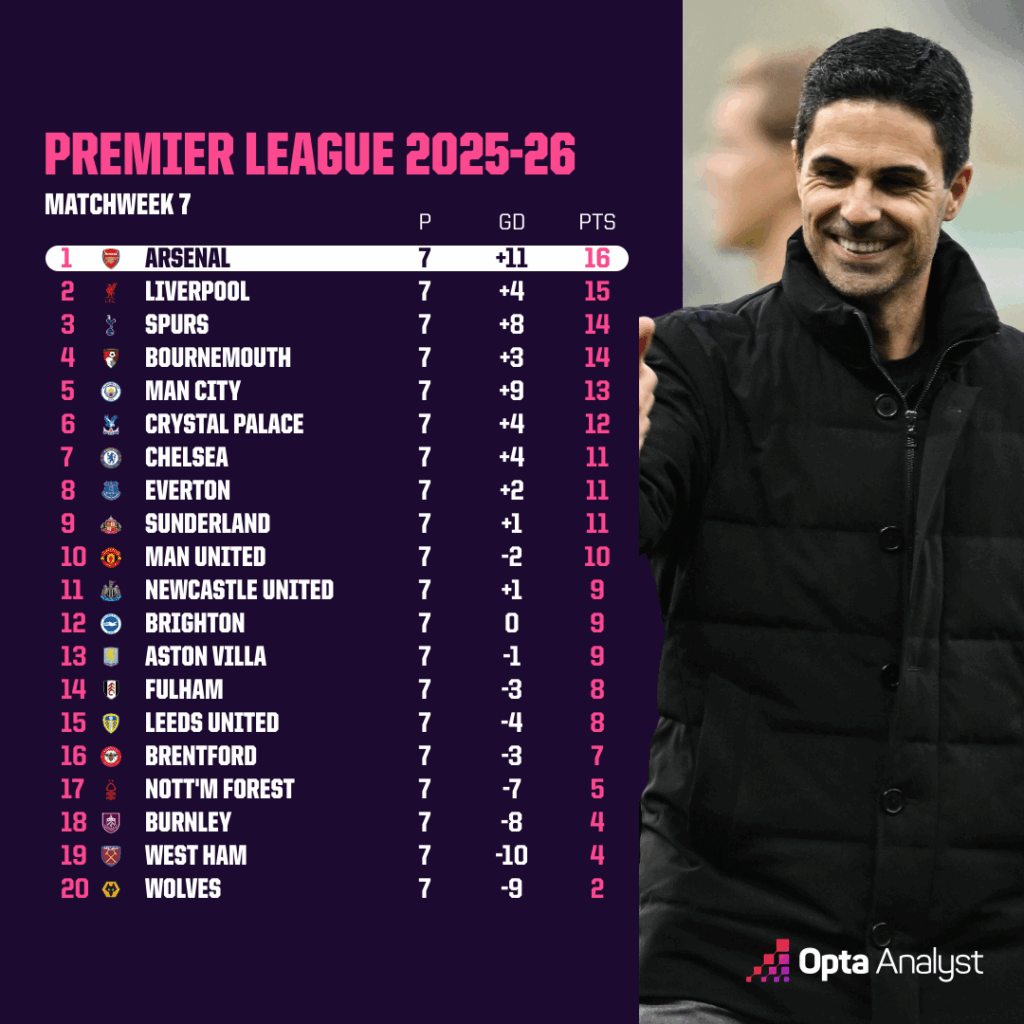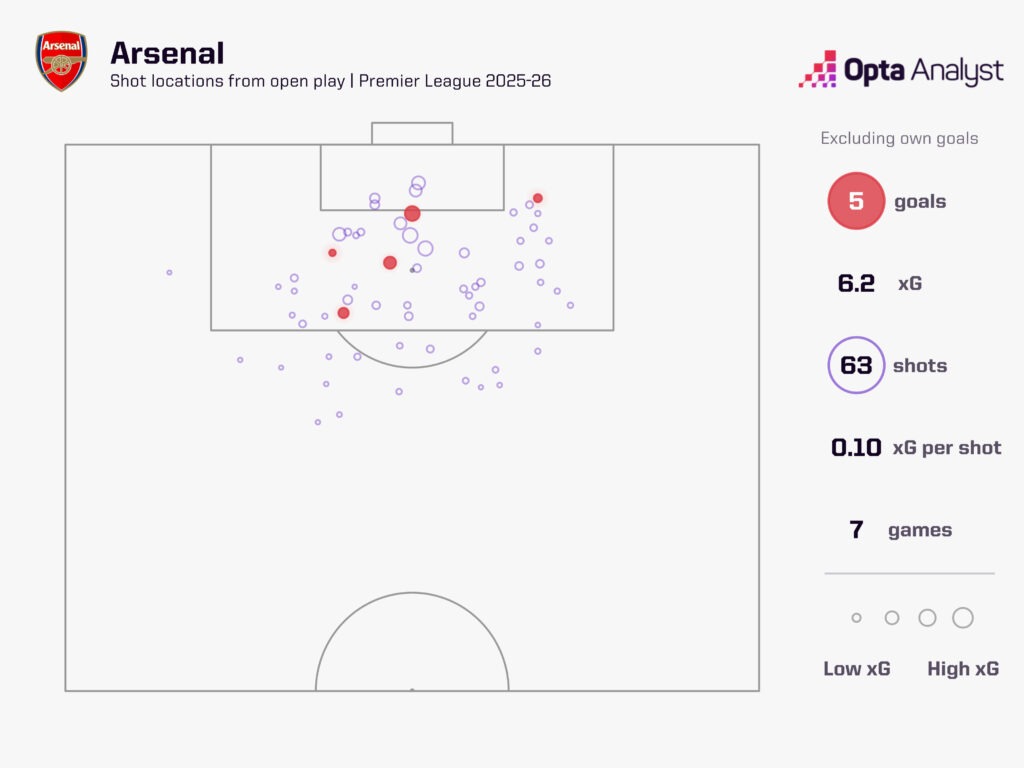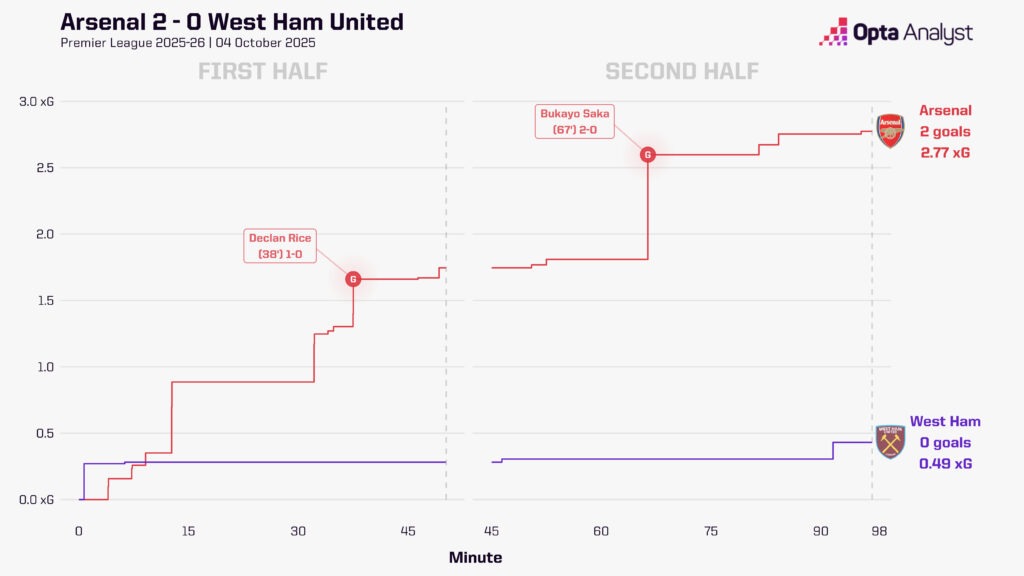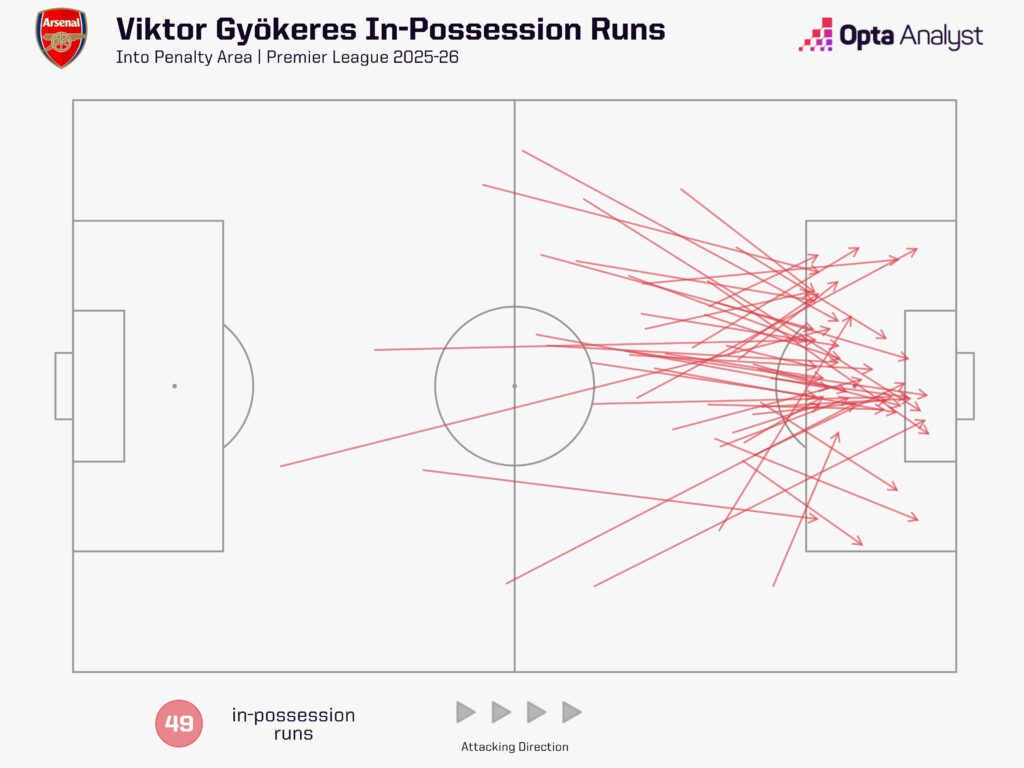Arsenal
are top of the Premier League and favourites to win the title with
the Opta supercomputer. Is their one-point lead somehow
unassailable?
We may only be halfway through October, but the most recent
Premier League weekend felt significant in the title race.
Aside from the end of Matchdays 1 and 2 of the Premier League
this season, MD7 was the first time in almost a year – since MD9 in
2024-25 – that Liverpool had not been top of the table at the
conclusion of a gameweek.
Last season, they went top after MD10 in early November and
could not be caught, retaining the lead for the next 28 rounds of
fixtures.
But now, Liverpool
have followed up their five-match winning streak at the start of
the season with successive defeats to Crystal Palace and Chelsea,
and as a result, lost top spot to Arsenal. The lead may only be one
point, but given how solid Mikel Arteta’s impressive side have
looked, it’s reasonable to wonder now whether they will be
caught.
A one-point lead with 93 points still to be played for is hardly
unassailable. It clearly isn’t. But at this early stage of the
season, Arsenal look incredibly strong and decidedly lacking in
weaknesses. The aim now will be to do what Liverpool did a year ago
and cling on to first place for the rest of the campaign.

Arsenal have had a tough start, already facing Liverpool,
Manchester
City, Newcastle
and Manchester
United, with their league-topping record built on the firm
foundations of their exceptional defence.
Arsenal have conceded only three goals in seven games despite
playing some very good teams, giving them the best defensive record
in the Premier
League. They also lead the top flight for expected goals
against (xGA), having allowed their opponents chances worth just
4.39 xG across their seven games.
They have David
Raya to thank in part for their overperformance of 1.39
compared to their xGA, but even if they had conceded goals exactly
in line with their xG, they’d still be letting in under a goal a
game. Even conceding goals at that rate, Arsenal would still have a
very good chance of winning the league.
At the other end of the pitch, they appear to be finding their
feet after coming in for some criticism for being too reliant on
set-pieces, while accusations of them “playing with the handbrake
on” were persistent after they fell to a 1-0 defeat at
Liverpool.
But they rank third in the Premier League for xG, with 12.2.
They have had at least 43 more touches in the opposition’s box
(249) than any other team, and even when discounting set-pieces,
they have fared decently enough creatively, ranking seventh for xG
from open play with 6.2.
And they’ve actually only scored five goals from that 6.2 xG, so
they could have done even better in open play with slightly better
finishing.

Their incredible record at set-pieces is sometimes used as a
stick to beat them with because it can appear they are
only really trying to score from corners and don’t make
use of their attacking talent to beat teams in open play.
But what then should be said of their most recent results –
consecutive 2-0 wins over Olympiakos in the Champions League and
West
Ham in the Premier League – in which they created tonnes of
chances in open play and didn’t require a corner or free-kick
goal?


Those wins took Arsenal’s winning streak to four games, and they
have won eight of their 10 games this season, conceding just three
goals. They appear to be better than they were last season, and the
Opta Power Rankings agree; Arsenal are now ranked as the best
team in the world according to our model.
Arteta went big in the summer transfer window, and the evidence
on the pitch suggests the club’s recruitment has been
successful.
Strengthening the first XI of a team who had just finished
second in the Premier League for a third successive season was
always going to be a tough task, but
Martín Zubimendi has strengthened their midfield. He sits in
front of the defence, breaks up play and distributes the ball
effectively, while also adding an attacking threat of his own,
having scored twice in seven appearances.
Otherwise, Arsenal have mainly added depth, but each of Eberechi
Eze, Noni
Madueke, Viktor
Gyökeres and
Cristhian Mosquera could yet prove to be first-XI players. They
have all provided value by covering for injured first-teamers in
their short time in north London. Kepa
Arrizabalaga,
Christian Nørgaard and Piero
Hincapié are also good additions.
Injuries have been a significant contributing factor in Arsenal
not quite getting over the line in the league or Champions League
under Arteta, and that was particularly evident last season, when
they suffered in the absence of Martin
Ødegaard, Bukayo
Saka and Kai
Havertz. In 2022-23, their title challenge fell apart when
William
Saliba missed the run-in with a back injury.
This season, they have already had to make do without each of
them due to injury, and for a period without all four, after Saliba
lasted only four minutes of their trip to Anfield before being
forced off.
In the absence of those players this time around, Arsenal
haven’t looked anything like as badly off as they have been
previously. Eze adds some creative spark they lack without
Ødegaard; Madueke is probably the best back-up right-sided attacker
in the country; 21-year-old Mosquera looks like a bargain at £13
million, having taken to life in the Premier League so ably.
Gyökeres is the only one of those four for whom the jury remains
out, but even if goals haven’t flowed as freely as he, Arteta or
any Arsenal fan would have liked, he is still creating space with
his movement and occupying defenders consistently.
He has made more off-ball runs into the opposition’s box (49)
than any other player in the Premier League this season, and is
clearly working hard to make this move a success. It’s also worth
mentioning that he is Arsenal’s top scorer in Premier
League games with three goals, so it’s not like he’s made a bad
start. That said, when Havertz does return, it will be interesting
to see who Arteta opts for up front.

In essence, the greater strength in depth has made Arsenal less
reliant on any individual player. Losing Saka or Saliba isn’t felt
anything like as severely, though the biggest challenge may come in
the next few weeks. With Ødegaard out with a knee injury, Eze will
need to step up and start reproducing the form he showed at Crystal
Palace last season.
Although Arteta would never have wished for them, all these
injuries have helped Arsenal in one sense. They have allowed the
new players who were expected to be on the fringes of the first
team game time they wouldn’t otherwise have got. Arsenal now go
into the bulk of the season knowing there’s less reason to fear an
injury to a key player.
The biggest threats to Arsenal’s season are probably Ødegaard’s
injury turning out to be more serious than first feared and Eze not
proving an adequate replacement, or Gyökeres failing to find his
goalscoring touch. But they do look better set up to contend with
either of those concerns.
Another potential issue, however, is the fine margins this team
can risk playing with. They are slightly more risk-averse than
their title rivals, and that has played out this season as them
being a little too reliant on their water-tight defence.
What that means is, when they do concede, they can struggle. In
the three games they have conceded a goal this season, they have
either dropped points, as was the case against Liverpool and
Manchester City, or very, very nearly dropped points, as was the
case against Newcastle before Gabriel Magalhães’
injury-time winner. They also needed a last-gasp equaliser to
take a point off City.
As Liverpool have found in the last couple of weeks, relying on
injury-time winners, as they did in the early part of the season,
isn’t sustainable.
What Arsenal are doing, however, does look rather more reliable.
They are top of the Premier League and they deserve to be, too,
according
to Opta’s expected points model, which uses expected goals data
to assess how each game ‘should’ have finished based on the quality
of chances each team created. Arsenal are the only team in the
Premier League who are currently in the exact position the model
says they deserve to be.
In part because of that, following last weekend’s deposing of
Liverpool at the top of the actual table, the Opta
supercomputer now makes Arsenal favourites to win the title. They
are victorious in 44.0% of 10,000 simulations of the rest of the
season run by the supercomputer. So, in almost one in every two
simulations, there was no overturning Arsenal’s one-point lead
after seven matchdays.
They’ve been top before. They’ve also been the supercomputer’s
favourites for the title before, too. However, they haven’t been
top since 13 May 2024, when second-placed City had a game in hand
on them, and they haven’t been favourites to win the league with
the supercomputer since 9 April 2023, at the end of 2022-23, when
they fell apart without Saliba.
But this time, things feel different. They are different. In a
title race packed with flaws, they are the least flawed team, and
by some distance. They have been the best team in the league this
season. There’s good reason they’re favourites.
It’s still incredibly early on in the season – obviously far too
early to call the title race. But Liverpool had the lead from
Matchday 10 onwards last season, and there is a chance Arsenal
could hold on to it from even earlier this time around. On the
evidence of their very solid start to 2025-26, they don’t look much
like giving up their lead.
Enjoy this? Subscribe
to our football
newsletter to receive exclusive weekly content. You can
also follow our social accounts over on X, Instagram, TikTok and Facebook.


